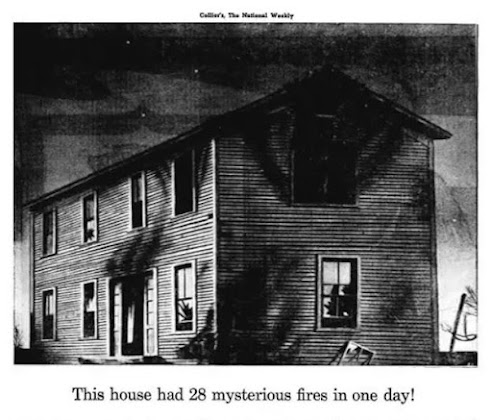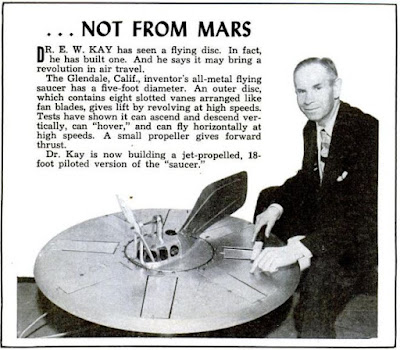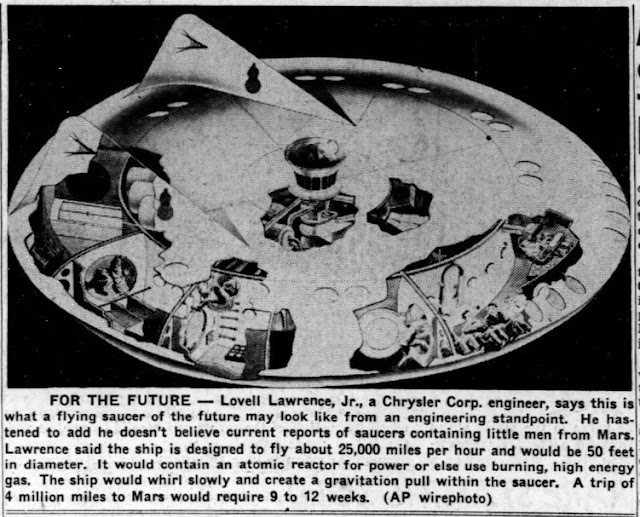
On Feb. 22, 1966, a call alerted authorities to the discovery of a flying saucer in a wooded area near Shelton, Washington. The “Thing” was left in place, but photographed and examined. Guesses ran wild as to what it was, where it came from, and why it was there.
The object was a strange craft, about as tall as a person, with a diameter of over 12 feet. Reserve Sheriff Deputy Chuck Shelton examined the object and reported that it sat on a pair of steel rails and was powered by a Ranger aircraft engine, equipped with two acts of rotor blades, 12 to a set. “In paint partly obliterated are the words Grayland (or Grayson) Aircraft Manufacturing Company.” The saucer was apparently made in the U.S.A. The Daily Olympian, Feb. 23, 1966, playfully asked:
“How did the Thing get where it is in the woodlot of A. D. Hunter who lives part of the time in California and the rest of the year on his Matlock Ranch? Did it fly? Was the pilot a man – or a jolly green giant?” The story went on to say that there was a shortage of information; the Sheriff and his deputy were both out of town, and Mr. Hunter hadn’t been heard from. “So there it sits. A Thing from Detroit, or Disneyland - or Outer Space.”
Three days later, A. D. Hunter returned and discovered there was a fuss over the discovery on his property. It turned out the flying saucer speculation was right. He was able to identify the Thing as a flying disc prototype built a few years prior by inventor Leonard. W. Grayson. Hunter was quoted as saying, “I really don’t want the hovercraft, but since it was a pilot model, my brother-in law didn’t want to scrap it, so he hauled it to my place about three years ago.” He said Grayson had moved to Montana and was manufacturing an improved version of the aircraft.
That wasn’t quite the end of the Thing, though. Or the career of its inventor. Leonard W. Grayson’s career is like many others, in that we have only bits here and there of what the media printed about him. No doubt, there’s more to the story than we’ll ever know. It’s not recorded what Grayson thought about UFOs and aliens, but it’s well-documented that he built and flew flying saucers.
A Wheel in the Middle of a Wheel
Leonard William Grayson was born on July 21, 1918. He didn’t have a degree or attend college, but he had served as a corporal in the US Army during World War II as an instrument technician. Afterwards, he returned to civilian life as a working family man in Cascade, Montana.
While employed as a railroad agent telegrapher in 1954, he had a “Eureka’ moment:
“All at once those wheels were going around me. Just floating around me. I hadn't been consciously designing a vertical lift machine and it was amazing how the whole thing fell into place… within a few minutes… the whole design was formulated, and I drew a sketch of it.”
Working in his spare time in his garage, Grayson designed and constructed several flying disc models, assisted by his wife Lucy, their two sons, Richard, and Tom. Meanwhile, in his day job, he was employed over the next few years as a carpenter, and a civil engineer technician.
Grayson’s design featured two non-axial, counter-rotating rings, to which blades for propulsion were attached. It generated a vertical lift that acted both as a rotor craft and a jet. His first successful working model was completed in 1956, a 30-inch diameter model, powered by a 3/8 horsepower electric motor. He filed a patent for his “Disc Shaped aircraft” on Oct. 10, 1955, saying the vehicle “may be employed with equal facility as an aircraft or as a land vehicle for traveling on the highways.” The patent was granted on May 3, 1960.
While waiting for the patent, Grayson began construction of a manned 21-foot, 1,600-pound test model powered by a 165-horsepower aircraft engine he’d bought for fifty dollars. He and the family briefly lived in Shelton, Washington, and that’s where he completed the disc and conducted test flights. It flew, but only a few feet off the ground, enough to satisfy him that with the proper facilities and financial backing it could be built and even scaled up for passenger flight.
Caption for 1965 article:
“21-Footer – This 21-foot model Grace-N-Air was built by Grayson in a garage at his home in Cascade. He began building the machine in March, 1959, and had it ready to get off the ground by July, 1960. Here the vehicle is shown as it was beginning to rise off the ground in a test. The outside duet, or framework is made of aluminum. Grayson was operating this machine which was powered by a 165-horsepower airplane engine. This picture was taken in Cascade [probably Shelton, WA] in the summer of 1960. This model since has been dismantled and is stored in a Seattle garage.”
(That caption was off, as we know the location was actually a heavily wooded field, where it was discovered as the Thing.)
Around 1963, the Graysons moved back to Montana and set up house in Bozeman. By 1965, Grayson was satisfied with the performance of his smaller models and began aggressively campaigning for his invention to be noticed by private industry and the US military.
The Billings Gazette, May 24, 1965, ran a story on the first Montana Inventors Congress. The second-most popular invention:
“…was a flying saucer built by Leonard Grayson of Dillon. Grayson said his Grace-N-Air Flying Saucer could be built with a 500-foot diameter and could carry 500 passengers. The one Grayson had on display is three feet in diameter and is powered by a five-horsepower electric motor… He said it will travel 60 miles per hour and that a larger model could go at least 300 mph.”
More publicity followed. The Great Fall Tribune Sunday magazine, Montana Parade, June 5, 1965, cover story was “Dillon Inventor’s Disc-Type Aircraft New Flying Concept,” story and photos by Clyde Reichelt.
Grayson’s invention was not built for space travel, and he didn’t bill it as a flying saucer. In March 1966, press about the UFO sightings in Dexter, Michigan, got the flying saucer fever going again. If the press was short on UFOs stories, they could run pictures and stories of Grayson’s discs. Apparently, he didn’t discourage them.
In June 1966, Montana State University film students, Tom Gordon and Don Tone made a short 16 mm color movie documenting Grayson’s aerodynamic concepts and inventions. The film included an animated sequence to illustrate the potential of the invention at a larger scale for applications such as those of conventional aircraft, including commercial transportation. The movie was granted a copyright in 1967, and Grayson exhibited the film at his public appearances and in meetings with prospective customers.
 |
GRACE-N-AIR. Leonard W. Grayson;. 22 min., color, 16 mm.
© Leonard W. Grayson;; 8Jun67; MU7837. |
Grayson was seeking a contract with the U.S. government, but figuratively speaking, when the phone rang, it was the flying saucer people.
Saucer Clubs and Conventions
We don’t know exactly when Leonard Grayson had his first contact with UFO buffs, but he was approached by Wayne. S. Aho, director of the New Age Foundation of Seattle, Washington. Aho had been lecturing on UFOs for years and claimed to have had contact with aliens. He had become a perennial guest at Contactee conventions, first an advocate for UFO “Disclosure,” then transitioning to a more spiritual and religious figure, promoting peace and harmony through alien teachings or whatnot. Aho had been involved with some shady characters, and narrowly avoided prosecution for the sale of bogus stock in the Otis T. Carr spaceship business.

The New Age Foundation held a UFO convention near Mt Rainier each year. Aho must have seen the February news about the “Thing” in the woods, and obtained permission from Grayson to have the prototype moved to Eatonville and the Flying M Ranch, the site of the convention. It was held July 15-17, 1966. The Associated Press published with some inaccurate details about Grayson and his work:
“Flying saucer fans gathered here for the fifth annual Interplanetary Age Convention... The fans also peered at a machine that once rose 15 feet… The machine, now a jumble of twisted metal and pipes was built by a Montana State University professor. Its counterrotating blades provided the lift. Wayne Aho, a retired major, believes the object will someday be enshrined in a museum.”
Instead, after the convention, thieves stole the Grayson saucer’s 165-horsepower engine. What happened to the Thing after that is lost to history.
 |
| The Billings Gazette, Aug. 20,1966 |
Space Research Inc. hosted a “Space Age conclave” on UFOs on Aug. 20-21, 1966, in Spokane, Washington. About 15 speakers were presented, Wayne. S. Aho, Lenora Croft, and Leonard Grayson gave a “demonstration of an earth-type flying saucer principle.”
The “Big Sky Research Group” club led by Mrs. Dorothy Hankins in Billings, Montana, invited Grayson to lecture for them and present his film as soon as it was completed.
 |
| Colorado Springs Gazette-Telegraph Colorado Springs, May 6, 1967 |
Grayson demonstrated his invention and won a 1967 inventor's prize.
"Leonard W. Grayson, Bozeman inventor of the ‘flying saucer’ which won him the sweepstakes award of the Inventors’ and Manufacturers’ exposition at Missoula Saturday. The affair opened Friday. Grayson, formerly of Antelope, now working for the railroad at Cascade."
Saucer Scoop, June 1967, reprinted a news item on Grayson’s entry into the Inventors Congress.
 |
| The Missoulian, July 17, 1968 |
In 1968, Leonard Grayson was billed as the main speaker for the seventh annual Northwest UFO-Space Convention held in Eatonville, WA, by Wayne Aho’s New Age Foundation. He demonstrated his saucer model and flight and showed the movie, “Grace-N-Air.”
As far as we can tell, that was Grayson's final UFO conference.
Growing Pains
At some point, Grayson stopped using his electric motor-powered saucer and began exhibiting a 34-inch model, its blades powered by air piped in from an external air compressor. The photo below is from a demonstration on Aug. 23, 1969 in Denver, Colorado.
Where the press is concerned, 1969 to 1973 were fairly quiet years for Grayson. Perhaps coincidentally, those were bad years for the UFO business in general.) In 1970, the Graysons moved to Hamilton MT, where they ran the Town Pump service station.
While developing a commercial model airplane version of the saucer to promote the project and raise funds, “… he sold stock to friends and formed a closed corporation. According to Grayson, when the friends became directors, they decided the idea was too big for one man and tried to wrest his patents away from him. The directors complained to the Security Exchange Commission (SEC) and an injunction was placed against further work on the Grace-N-Air. Grayson was cleared of charges by the SEC in 1975 but his work was held up for five years.”
 |
| U.S. Pat. No. 3,845,670; Issued Nov. 5, 1974 |
Grayson continued to promote the Grace-N-Air concept and film in public, for local officials, the Ravalli County Fair in Montana, wherever he could.
 |
| The_Missoulian, Feb. 24, 1974 |
 |
| The Ravalli Republic, Aug. 27, 1974 |
In 1975 he began working on a 20-foot manned fiberglass model that he hoped would eventually be mass-produced for commercial vehicle sale. The Grayson Research Institute, incorporated March 1, 1976
Things picked up for the UFO biz in late 1973 with the Pascagoula abduction story, and newspapers needed saucer stories again. Grayson was featured in The Missoulian, Oct. 16, 1977, updating his business efforts, and he received some prime time television exposure.
The Montana Kaimin, May 24, 1978 (University of Montana student newspaper) reported in “Leonard Grayson’s inventions are getting off the ground” by Judy Casanova:
“Grayson is an independent inventor and he and his wife have made four trips to Washington, D.C., at their own expense, to get the military interested in the concept of the Grace-N-Air. In February, Grayson was invited to the Defense Department in Washington, D.C. to make a presentation of the Grace-N-Air. … the Grace-N-Air has received national news coverage by NBC. Grayson said, "This may open some more doors to us."
The Final Flight
Richard L. Weir also lived in Montana and was friends with Grayson. They shared similar backgrounds and interests, and Weir devised a “Rotary Foil Type Aircraft” and applied for a patent in 1957, granted in 1964. Weir owned a Cessna 182 plane and was an experienced pilot, often accompanied on flights by his wife Mary.
On Feb. 19, 1980, Mr. and Mrs. Weir were joined by Leonard and Lucy Grayson on a fight to Mesa, Arizona to visit relatives. When they failed to arrive, their plane was reported missing. Severe winter weather delayed the search, but on Feb. 27, Civil Air Patrol and National Park Service searchers found the Cessna below the north rim of the Grand Canyon. The plane had crashed after hitting a tree, and all four aboard were killed.
Here's a link to the Richard and Mary Weir Memorial article. Below are the obituaries for Leonard and Lucy Grayson.
 |
| The Missoulian, March 5, 1980 |
We were unable to locate any information on what became of Grayson's film, "Grace-N-Air" or if copies still exist. Leonard Grayson is seldom mentioned in UFO literature and history. A rare exception was in the Journal of UFO History, Vol. 2 No. 1, March-April 2005, “US Patents for Disc Aircraft.”We have to wonder, what might have happened if the U.S. government or industry had ever made an attempt to produce a fully realized Grayson aircraft. With the advances in material construction and aviation technology in the decades since Leonard Grayson’s passing, how high might the Grace-N-Air fly today?
. . .
Thanks to STTF co-founder Claude Falkstrom for the primary research on this report. Also, thanks to researchers Roger Glassel and Jeff Knox for providing supplementary material.
P.S. Other Flying Saucer Discoveries
Most discoveries purported flying saucers turn out to be phonies or junk that never flew. Some of them have been from balloon-borne packages, intended for anything from weather study to espionage platforms. Besides Grayson’s Thing, there was one other discovery of a real disc-shaped aircraft. It was found in an old tobacco barn near Baltimore, Maryland in 1949.

.png)



























.png)

























